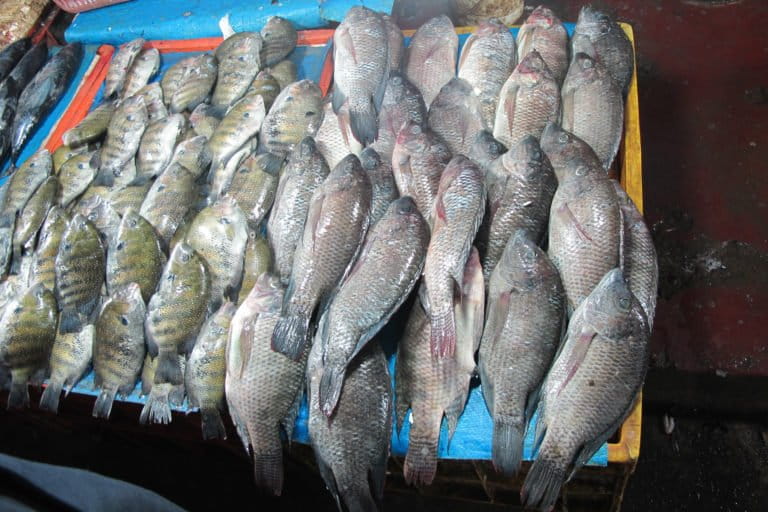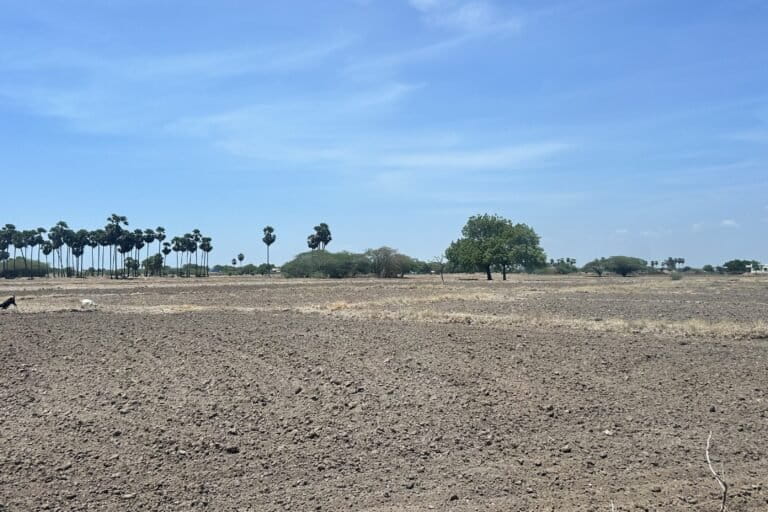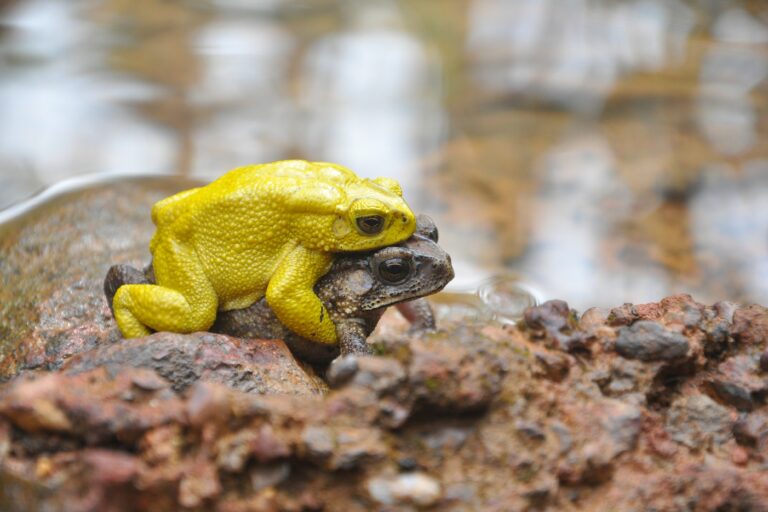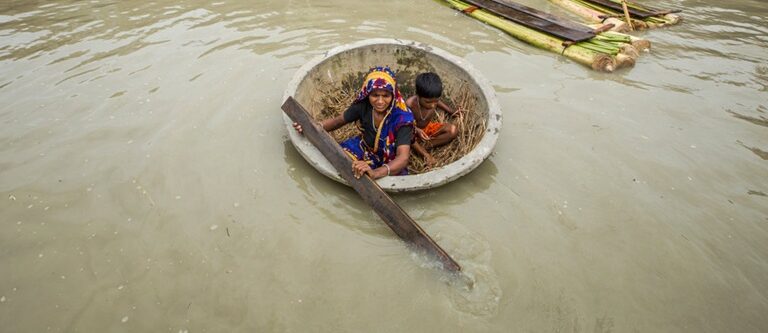- Tilapia are among several fish species belonging to the family Cichlidae, native to Africa and the Middle East. Their ability to adapt to a wide variety of conditions, their omnivorous food habits and their popularity in the aquaculture sector have resulted in tilapias being introduced to several parts of the world.
- The Mozambique and the Nile tilapia were introduced into India to boost food security. However, through both accident and intentional release, the species have established themselves through large sections of the country’s waterways, making their way into biodiversity hotspots as well.
- Creating a market for an invasive species like the tilapia, if not done with a clear understanding about their threat to local ecosystems and reasons for their eradication, can have serious consequences for natural ecosystems and ecosystem services.
- On the eve of the World Food Day (October 16), Aaron Savio Lobo examines the complex issues around tilapia in this commentary.
Karmali (also called Carambolim) is among Goa’s most picturesque railway stations, perched on the banks of the lake with the same name. The lake has long been known for the large congregations of wintering waterfowl that arrive here every year and is frequented by birders. It was even conferred the status of an Important Bird Area (IBA). I have been visiting the lake since the nineties, and more recently, with a bird photographer friend of mine, who was keen to photograph the lake’s resident osprey. While we were on the lookout, my friend drew my attention to the lake’s muddy banks. Large expanses of the banks and shallows were pockmarked with bowl-sized, crater-like excavations. I was similarly puzzled the first time I saw these otherworldly formations back in 2004 on the drying bed of the Vaigai river just outside Madurai in Tamil Nadu. The local fishers told me that the little craters were the nests of the Jalebi meen, referring to the Mozambique Tilapia (Oreochromis mossambicus). I found out that Jalebi was a corruption of the word Tilapia, which was apparently first called Jilapia and later corrupted to Jalebi; meen is Tamil for fish.
When it’s time to breed, the male fish swim in shoals to the shallows. The dominant ones transform themselves into an inky blue-black, the posterior margins of their fins sporting vibrant reddish-orange hues. They then dig their nest bowl, called a spawning bower, and defend it fiercely from other trespassing males, while courting approaching females. While the males remain confined to displaying at the nests, the females move from nest to nest, choosing the most suitable mate, in whose nest she will lay her eggs – a behaviour called “Lekking.”

Once the eggs are deposited, the male releases his milt (fish sperm) cloud over them. The female then gently scoops the eggs along with the milt into her mouth, where they are fertilized, with the fry (young) emerging in about three days. However, the fry will continue to refuge in their mother’s mouth and only be allowed to swim into the outside world after a good two weeks. Even after being released, the tiny fry stay close to their mother, retreating at the first sign of approaching danger. This behaviour is called “mouthbrooding” and mothers will not eat anything during this entire period.
The Mozambique Tilapia is a species native to Africa, specifically to the east-flowing rivers of Central and South Africa. They were introduced around the world as a way to boost food security through aquaculture in many developing countries. The first consignments of this species were imported into India way back in 1952, interestingly not from Africa, but from Thailand and Sri Lanka via the Central Marine Fisheries Research Institute (CMFRI) in Mandapam and the Madras Fisheries Department respectively (Panikkar and Tampi, 1954). This suggests that the Mozambique Tilapia had already begun establishing itself around the world. A little over two decades later (in the late 1970s), another species, the Nile Tilapia (Oreochromis niloticus) was brought into the country.

The Tilapia is now ubiquitous through the country, inhabiting freshwater streams, lakes, backwaters and even encountered out at sea. In parts of the country’s waterways, they constitute the dominant fish fauna. For instance, the Nile Tilapia is now among the dominant species in several parts of the Ganga and the Yamuna. They tolerate a wide range of conditions — from Chennai’s toxic Cooum river to the pristine waters of many of India’s national parks and sanctuaries. At the crocodile breeding center at Dangmal of the Bhitarkanika wildlife sanctuary in Orissa, the Tilapia is so abundant that it is used as a cheap and ready supply of crocodile food.
They have even managed to find their way into biodiversity hotspots such as the Andaman Islands and the Western Ghats. These areas are home to several endemic species found nowhere else. These endemic species have evolved in isolation, not developing defenses to cope with these invasive aliens.
However, not all exotic (non-native) species are invasive alien species. In fact, India has a large number of exotics brought by our erstwhile colonial rulers, which have become part of our landscapes, without necessarily posing a threat to ecology or economy. According to the IUCN, “An alien species is a species introduced outside its natural past or present distribution; if this species becomes problematic, it is termed an invasive alien species.”
The Mozambique Tilapia has made it to the list of “ One Hundred of the World’s Worst Invasive Alien Species on the Global Invasive Species Database.
Tilapias can very easily compete the native species by feeding on their resources, and although predominantly vegetarian, will happily predate on the eggs and young fish of native species. That said, they have also become prey to many native species, including birds, otter, crocodiles, snakes, etc. Tilapias are known to alter ecosystems; they can adversely impact ecosystem services, causing a decline in native fish catch in commercial and recreational fisheries.

In many ways, the Tilapia is also possibly the most globalized fish with feral tilapia populations now occurring in at least 114 countries. ‘Feral’ refers to the tilapia populations established in the wild either because of escape from aquaculture operations or being intentionally introduced to an area. They can contribute significantly to fisheries in an area.
The species were introduced globally from the remote islands of the South Pacific through Southeast Asia and the Americas. Mexico, followed by the Philippines and Thailand, dominates the global Tilapia landings from capture fisheries from feral fish populations. In Cuba and Nicaragua in Latin America, feral Tilapia now make up 100% of the catch landings of freshwater species (Deines et al., 2016).
This alien invader has been normalized in so many countries and has even become an integral part of their culture and cuisine, all in a matter of a few decades. I have enjoyed local seafood recipes featuring the Tilapia in several parts of the world. In a small town on the Pacific coast of Honduras, Gulf of Fonseca, I enjoyed the “traditional” Sopa marinera (seafood soup) prepared using Tilapia, being farmed in cages in the Gulf. I have also spent many an evening on Bangkok street markets feasting on salt-crusted grilled Pla Nin, which literally translates to Nile fish, where Nin is Nile and Pla is fish.

Farming Tilapia
Tilapias, along with various carp species, catfish and salmonids (which include salmon and trout), dominate fish production from the aquaculture sector. As of 2018, Tilapia made up ~10% of the total farmed fish production, with the Nile tilapia dominating this (FAO, 2020). China is the largest producer of farmed Tilapia and produces over a third of the global supply. Tilapia aquaculture operations can range from small backyard ponds to industrial scale enterprises and include a diversity of methods including tanks, floating cages and recirculating aquaculture systems (RAS).
Despite its well-acknowledged risk as an invasive alien species, it is often listed as a sustainable seafood choice for consumers and has even been included under “Best Choices” of the well-known US-based Monterey Bay Aquarium seafood consumers guide – Seafood Watch. This primarily has to do with its vegetarian feeding habits, in contrast to the other coastal species gaining popularity in India such as Asian sea bass (Lates calcarifer) and Cobia (Rachycentron canadum) that still depend on fishmeal from wild-caught fish, which is not sustainable in the long run. This has resulted in the Tilapia aquaculture being promoted in a big way the world over.
The Impostor
In many places in India, the Tilapia seems to be even threatening our local fish delicacies, literally “right under our noses.” The Pearlspot/ Green chromide (Etroplus suratensis) is a brackish water fish common through the Indian subcontinent. The Pearlspot also happens to be the state fish of Kerala, locally known as Karimeen. Incidentally, the Karimeen and the Tilapia belong to the same family of fish Cichlidae and kind of resemble each other. When coated with the spicy red masala paste and wrapped in a banana leaf as is done in the case of “Karimeen Polichathu,” a signature Malayali delicacy, the nouveau piscivore would find it difficult to tell the difference between Karimeen and the Tilapia. Mislabeling is a common malpractice in the seafood market place, and happens particularly when the fish of choice has declined.

To Eat or Not to Eat
“Invasivorism,” which is the consumption of invasive species, has often been touted as a solution to controlling their populations. Conservation scientists have teamed up creatively with chefs in the hope that the increased harvesting and consumption of these critters will lead to their overexploitation, just like the way people have driven declines in native species, sometimes to extinction. While this may sound like a smart solution that has been tried in several parts of the world, its effectiveness is largely contested.
Creating a market for Tilapia, if not done with a clear goal about their threat to local ecosystems and reasons for their eradication, can have the opposite effect and continue to allow for their propagation. Also, if these invasive species become economically valuable, people may introduce these in previously uninvaded regions. This constitutes a huge threat to local biodiversity as well as food security in the region.
While the farming of Tilapia was banned in India since 1959, the government lifted the ban for the culture of Nile tilapia in 2012, albeit with strict guidelines that address issues pertaining to biosecurity, among many others. (Anon, 2015). However, actually enforcing these guidelines is far from an easy feat. Moreover, while they are possibly executed with every best intention to boost food security, these fish monocultures often ignore the potential fallout to nutrition security on poor communities. This is because of the substitution of diverse indigenous species with monocultures of Tilapia in our waters and our diets.
I recently visited an integrated pig-fish farm somewhere off the upper reaches of Goa’s Chapora river. The man who ran the operation told me that he had a piggery, which he maintained with food waste from hotels, a common practice employed by piggeries in the state. The pig dung is used as a fertiliser to trigger algal blooms on which Tilapia (both species) were fed. The Tilapia he maintained were not to be sold in the market for food, rather maintained as live feed for his main revenue generator Asian Sea Bass, which were being farmed. He also runs a small tourist venture on the side where anglers can come and fish in his Tilapia ponds and you can pay for your catch by the kilo.
While this whole operation at a glance appeared fairly closed-loop and would be commendable to most, I had the chills thinking of potential fish “spillovers” when the rains lash the state and the open lakes overflow into the surrounding waterways.
Read more: Enormous alien fish spotted in Kerala’s rivers after the 2018 floods
In many ways, the threat of invasive alien species is analogous to new emerging viruses that threaten our lives. Both are, in a way, the negative fallout of the hyper-global world we live in. In the case of invasives, the threat is far more pernicious and often escapes our eyes. These include irreversible degradation of ecosystems, the silent extinction of native species and, ultimately, the homogenization of our ecosystems and diets.
Once they “get out,” controlling them is no easy feat. The age-old adage “Prevention is Better than Cure” holds true here more than anywhere else.

CITATION
Anon, 2015. Guidelines for responsible farming of Tilapia in India. National Fisheries Development Board.
FAO, 2020. FAO. 2020. The State of World Fisheries and Aquaculture 2020. Sustainability in action. Rome.
Deines, A.M., Wittmann, M.E., Deines, J.M., Lodge, D.M., 2016. Tradeoffs among Ecosystem Services Associated with Global Tilapia Introductions. null 24, 178–191. https://doi.org/10.1080/23308249.2015.1115466
Panikkar, N.K., Tampi, P.R.S., 1954. Mouth-breeding cichlid, Tilapia mossambica Peters. Indian Journal of Fisheries 1, 217–230.
Aaron Savio Lobo is a marine conservation scientist and a member of the IUCN SSC Marine Conservation Committee. His work has largely focussed on understanding the ecological and socio-economic costs of food production and providing solutions through policy and practice (which includes gastronomy). You can read more about his work on his blog Last Chance to Feast.
Banner image: The Mozambique tilapia (Oreochromis mossambicus) made it to of the “100 of the World’s Worst Invasive Alien Species.” Photo by Aaron Savio Lobo.














